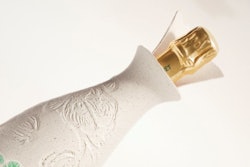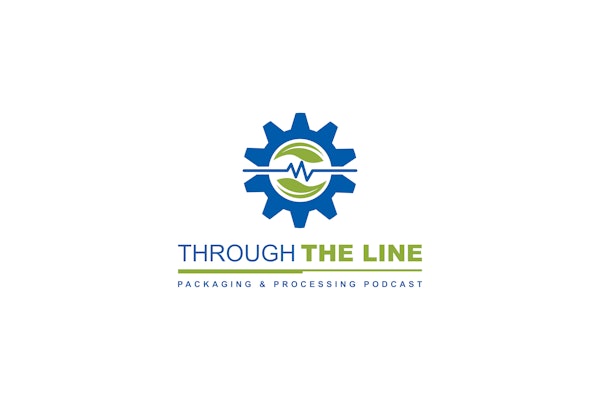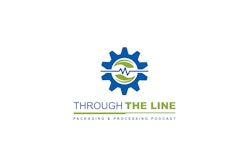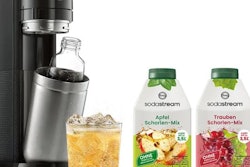
Privately held and founded in 1946, Tokyo-based Pentel Co., Ltd., has its U.S. headquarters in Torrance, Calif. Pens, pencils, markers, and erasers are what the firm is all about, and like others who operate in the same space, blister packs have long been the packaging format of choice for a lot of Pentel’s output. But early this year the firm introduced ball-point pens in plastic-free all-paper Paperblister™, and by the end of this year the plan is to have a great many more SKUs in a similarly plastic-free format.
As we’ve seen in so many other breakthroughs where sustainable packaging is concerned, Pentel had an indispensable partner in its journey, and that partner was—and is—Sonoco Alloyd. Also part of the picture was a brand manager tasked with making the plastic-to-paper transition happen, who in this case was Jason Cole, a ten-year veteran of Pentel. He says the process, which began in earnest around the end of 2019, had promising underpinnings right from the start because Pentel was already firmly established as a leader in the sale of refill cartridges for its pens.
“With 85% of the products we sell being refillable, we felt we were already a legitimate thought leader, a sustainability change maker in the category,” says Cole. “At some level it was a matter of ‘reimagining’ our packaging with the same green approach we’d already been taking with refills. And we wanted our packaging to sort of shout it out, you know, to make someone stop and notice that there’s something different here. So that consumers encountering our product in the store would say, ‘Hey, I can buy this one pen and use it for years and years without having it go to the landfill. And not only is the product itself refillable and reusable, it comes in a sustainable package. Now that’s a company that’s really putting its money where its mouth is.’ And that’s why we started down this path with Sonoco.’’
Cole and colleagues considered a number of suppliers as they started their journey. Sustainable packaging materials other than paper were also evaluated. But it quickly became evident that materials other than paper would likely involve all new packaging machinery plus an extended period of time in which to get that machinery up to speed. As for which supplier to partner with, Sonoco Alloyd had two key things working in its favor. First, Pentel already had three Sonoco Alloyd packaging machines in its Ontario, Calif., plant and another six in Tijuana, Mexico. “They know our equipment and said they could retrofit an existing machine to do a paper blister on it,” says Cole. Needless to say, that was mighty appealing from a capital expenditure perspective—because Pentel had existing Alloyd sealing equipment that could easily be retrofitted, the decision to move toward this structure was an easy one. The card backing, which acts as the consumer-facing front of the pack on a retail peg, is a 20-pt. C2S SBS that’s offset printed in a four-color process.
The card backing, which acts as the consumer-facing front of the pack on a retail peg, is a 20-pt. C2S SBS that’s offset printed in a four-color process.
“The beauty of that,” says Cole, “is it meant we wouldn’t need to spend time seeking out a third party for consumer research or design. And believe me, we did have some concerns about how this new look would be accepted. Not only by the consumer but by our own internal sales force. Having the R&D expertise of Sonoco insights and Alloyd manufacturing behind us reassured us that we were on solid ground. They know how to do both the qualitative and quantitative consumer research needed to convince our internal stakeholders that this was not only the right thing to do from an environmental and social standpoint but also the right move from a consumer standpoint. And that was one of the things we learned in our research work, that there actually is consumer appetite for a more sustainable package.”
Learnings along the way
 The paper blister portion is a 14-pt. SBS C1S that is offset printed in black only.
The paper blister portion is a 14-pt. SBS C1S that is offset printed in black only.
But even with that part of the puzzle resolved, the team still had to wrestle with whether or not product visibility could in fact be jettisoned. “What we came to realize is that all that billboard space we now have is where we can communicate some really important messaging, like the fact that what we are offering is refillable, reusable, and recyclable,” says Cole. So product visibility was not a feature of the package first launched.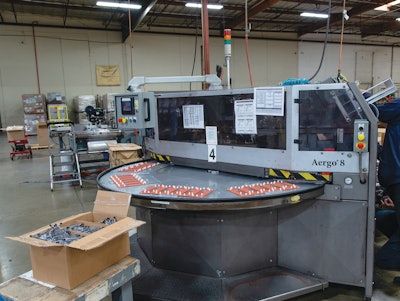 Pentel had existing Alloyd sealing equipment that could easily be retrofitted, simplifying the decision to move toward this structure.
Pentel had existing Alloyd sealing equipment that could easily be retrofitted, simplifying the decision to move toward this structure.
By early this year Pentel’s Ontario plant had its first retrofitted Sonoco Alloyd machine ready to roll. “Actually, it went surprisingly well,” says Cole. “The tooling arrived in the morning and I think they were up and running samples by noon. We ran about 500 samples, mostly to make sure everything worked with inner and master cartons. We sent out some samples to sales so they’d have an idea of what’s coming, and we asked Sonoco Alloyd to make some minor tweaks. At that point, we started receiving production cards and blisters, and we ran the first Purchase Order in January 2023.”
The first SKU to appear in plastic-free packaging on a store shelf was Pentel’s most-popular ballpoint pen, RSVP, in both two-count and five-count formats. Among the things Pentel management wanted to establish once the retrofitted machinery was in operation was if they could run as fast, and if they needed the same number of operators. The answers? “We think we can reduce the number of operators by one and we’ll be able to get higher throughput with the plastic-free packaging,” says Cole. “So now we’re looking at transitioning other SKUs, and we think we can do it considerably faster than we’d originally anticipated. Having said that, it will be important in this next phase to pay close attention to training staff on the retrofit machines as we go from traditional blister packs to this plastic-free package. We’ll also need to retrofit a machine in our Tijuana facility. We’re very excited about all of this, but we have a very cautious leadership team that’s going to want to see the numbers before leaping forward.” Speaking of the leadership team, Cole emphasizes how important it was that top executives from the president on down were deeply engaged in all stages of consumer research, design, and development.
Product visibility likely to resurface
Cole also indicates that while the package launched first did not include a die cut window providing product visibility, that won’t necessarily be the case as additional SKUs make the transition. As far as paperboard specification goes, the card backing, which acts as the front of the pack on a peg in retail, is a 20-pt C2S SBS that’s offset printed in a four-color process. The paper blister portion is a 14-pt SBS C1S that is offset printed in black only. A flat paperboard blank is picked from a magazine and formed into a blister on the equipment.
A flat paperboard blank is picked from a magazine and formed into a blister on the equipment.
When asked if the retrofitted packaging machine can now produce either traditional or plastic-free packaging, Cole says the answer is yes. “It doesn’t take much more than 30 minutes to make the switch. This gives us some welcome flexibility in the Ontario facility. All the same, our goal is to keep it retrofitted and make that a dedicated plastic-free machine. We just need to identify enough SKUs to transition to plastic-free to keep it busy for two shifts.”
Specific details on how the retrofitted machine operates are considered proprietary by Sonoco Alloyd. But one thing that must be quite different is dictated by the fact that the machine no longer picks a preformed plastic blister and places it in a nesting tray on the circular turntable. Instead, a flat paperboard blank is picked from a magazine and formed by the machine. Forming occurs mechanically after the blank is dropped into the nesting tray. Alloyd has engineered the tooling to perform this action prior to product load. Depth of draw is less than 1-in.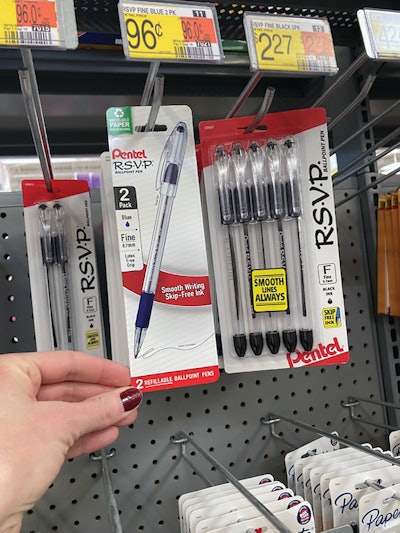 The new Pentel RSVP paper blister pack format on-shelf at retail, among examples of RSVP’s legacy plastic blister.
The new Pentel RSVP paper blister pack format on-shelf at retail, among examples of RSVP’s legacy plastic blister.
Cole emphasizes that while the transition to plastic-free packaging is in its early stages in terms of the number of SKUs that have been converted, momentum is building internally. One tweak to the currently available five-pack that’s in the works now is the addition of the Sustainable Packaging Coalition’s How2Recycle logo, the standardized indicator aimed at clearly communicating recycling instructions to the public.
Equally important as Pentel continues along this journey is that retailers are also enthusiastic. “Walmart says keep going,” says Cole. “Remember, they have an internal initiative called Project Gigaton that aims to inspire suppliers to reduce upstream and downstream greenhouse gas emissions from the global value chain. Because our initiative is so in line with Project Gigaton, that makes the buyers at Walmart very enthusiastic. Which is why we are moving ahead with Phase 2 and Phase 3 and hope to have the full Walmart planogram complete by the end of 2023. We’re also capitalizing on our plastic-free packaging initiative as an opportunity to streamline pack variety, both primary packs and master packs. As we continue this inventory house-cleaning process, as it were, the idea will be to use the same backing card and paperboard blister for multiple SKUs.” Forming occurs mechanically after the blank is dropped into the nesting tray. Alloyd has engineered the tooling to perform this action prior to product load. Depth of draw is less than 1-in.
Forming occurs mechanically after the blank is dropped into the nesting tray. Alloyd has engineered the tooling to perform this action prior to product load. Depth of draw is less than 1-in.
Looking back over the last two or three years of ideation, research, development, consumer feedback, and now at last commercialization, Cole adds this.
“If you’re a brand looking for a way to build affinity with your consumers and to live your values as a brand, you have to look inward to your processes. And packaging is a huge one. We estimate we’re putting 27 million plastic blisters out into the world each year. If sustainability and building better communities are among the pillars of Pentel, we need to live those values. So it was easy enough to commit to transitioning away from plastic in our packaging in terms of living our values. It was only as we got deeper into the execution phase and looked at how to deliver similar form factors across multiple categories that we realized how challenging such a project is. Fortunately, we discovered along the way that this project offers us opportunities to increase throughput and reduce the number of packaging varieties we keep in inventory, so it turns out there is also an internal economic benefit to the transition. Originally we just hoped to stay cost neutral. But we think in the long run we’ll be able to run faster and the inventory kept in our warehouse will be reduced. So while we started with the goal of living our values, we also think we’ll see a financial windfall as well.” PW





